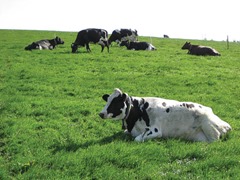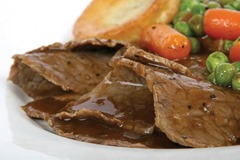Prospects for livestock production on the up
 Despite the impact of weather conditions, Northern Ireland’s dairy, beef and poultry sectors face a bright future as they seek to feed a growing world population. Richard Halleron reports.
Despite the impact of weather conditions, Northern Ireland’s dairy, beef and poultry sectors face a bright future as they seek to feed a growing world population. Richard Halleron reports.
There’s an old saying in the west of Ireland: ‘Live, horse and you will eat grass.’ Its significance has been brought home to me over the past twelve months by the fact that farmers throughout Ireland during this period have been dealing with the most horrendous weather-related problems while, at the time, being told – mostly by people like me – that the future for agri-food is so positive.
The last 12 months have seen local farmers having no option but to micro-manage their businesses on a daily basis. However, looking forward towards the bigger picture, the fundamental reality is that the prospects for production agriculture here in Northern Ireland are extremely bright. And our dairy, beef and poultry sectors are extremely well placed to capitalise on the opportunities that lie ahead.
The fundamental driver for this optimism remains the fast growing demand, particularly in countries such as China and India, for high quality animal protein-based products. The world’s population is set to increase by 50 per cent between now and 2050. This population growth will take place in the fast-expanding economies of Asia, where we are already seeing a significant shift towards what could be regarded as a western diet.
Our dairy sector is particularly well placed to avail of these strengthening market opportunities. To put it bluntly, consumers in Chinese do not trust their own milk sector. One only has to reflect on the numerous health scares which the Chinese dairy sector has been embroiled in over recent years to realise why this should be the case.
Northern Ireland is home to 300,000 dairy cows, producing 1.6 billion litres of milk annually. Approximately 85 per cent of this output is exported in the form of powders, cheese and butter. All of the international market indicators point to a very strong demand for dairy commodities being maintained over the coming months. May of this year saw producer milk prices break through the ‘all important’ 30 pence per litre barrier. And there is every likelihood of these farm gate returns being maintained well into the autumn.
Northern Ireland’s key advantages on the world’s dairy markets centre on two fundamental drivers: our ability to produce large quantities of high quality milk from grass and the industry’s proven track record in delivering full product traceability from farm to plate.
So, yes, the future for milk production in Northern Ireland is bright. But there is no room for complacency at farm level. The spectre of rising input costs continues to cast a dark shadow over the industry. And farmers’ response to this challenge must come in the form of securing higher levels of production efficiency.
Shorter supply chain
The history books will confirm that the ‘horse burger scandal’ of 2013 turned out to be one of the significant boosts ever received by the beef industry here in Northern Ireland. Talk of horsemeat coming into the UK food chain from mainland Europe forced all of the UK supermarkets to publically commit to sourcing all of their fresh beef products from bona fide suppliers in Northern Ireland, England, Scotland and Wales.
The local beef industry accounts for
20 per cent of the UK’s total beef output. So the obvious commercial benefits to both local processers and farmers of the decision taken by the supermarkets to drastically shorten their beef supply chain become immediately obvious.
In contrast to the dairy industry, which markets its products around the world, Northern Ireland’s red meat sector is very much focussed on supplying the British supermarket trade. The reasons for this can be traced back to 1996 when the BSE export ban was introduced. At that stage, processers in Northern Ireland had no option but to concentrate their energies in developing marketing opportunities in England, Scotland and Wales. Approximately, 80 per cent of the beef produced in Northern Ireland is destined for export.
Thankfully, the BSE ban was rescinded a number of years ago and local beef processers are now actively securing markets in mainland Europe and further afield. As a consequence, they are able to get better prices for the entire range of beef products they sell. This, in turn, should lead to improved producer prices during the period ahead.
Farm gate beef prices have, in fact, increased significantly over the past year. Supply/demand factors and the aforementioned horse burger scandal have contributed to bringing about this welcome state of affairs.
Branding of locally produced beef is still the exception, rather than the rule. However, this may be about to change. Recent months have seen all of our main red meat processers join forces with the supermarkets to promote the quality of the beef produced by our traditional cattle breeds. Hereford and Aberdeen Angus producer schemes are now offering price premiums of up to 55 pence per kilo for all certified cattle submitted for slaughter.
The sales pitch to consumers also highlights the fact that the beef on offer is produced from grass-fed cattle only. And it is working.
Demand for the beef is growing exponentially. Local beef farmers would be fools not to consider seriously the opportunities which the range of Angus and Hereford producer schemes now offer.
The development of the poultry meat sector has been at the very heart of the growth enjoyed by Northern Ireland’s agri-food industry as a whole over recent years. Fuelled by the explosion in consumer demand for fresh chicken, broiler producers and processers have managed to combine vertical integration and scale of operation in a more than effective manner.
Moy Park, by far the major player within the industry, currently enjoys a turnover of around £1 billion per annum. The company has secured a 20 per cent annual rise in throughput for the past number of years. Currently its weekly production amounts to 2 million birds per week. However, management within the business have made it quite clear that the potential now exists to increase this figure up to 3 million birds within the next year. This enhanced level of throughput will be driven by the UK supermarkets’ commitment to secure all of their fresh poultry meat from UK sources in the wake of the horse burger debacle.
All of this will necessitate the construction of three hundred new poultry units on farms across Northern Ireland. Moy Park management have made no secret of the fact that they would like the Executive at Stormont to support the envisaged expansion in the poultry meat sector.
For their part, the banks have never baulked at funding new broiler units here in Northern Ireland. So, irrespective of where the money comes from, a significant expansion of the local poultry meat sector is very definitely on the cards.






